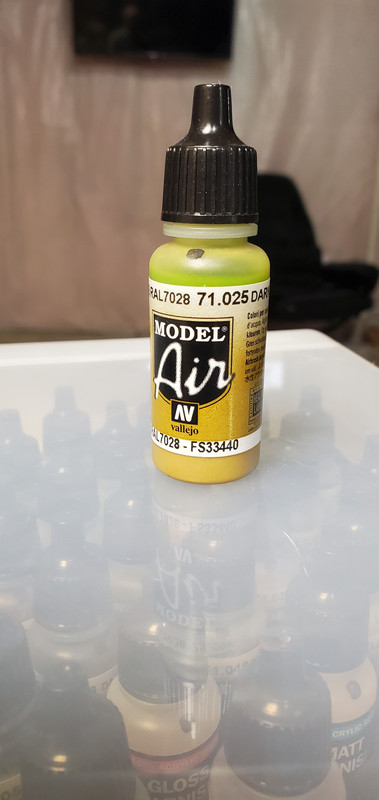Having several yrs experience with Vallejo Model Air, and some time on my hands, I thought I'd toss in my 2 cents.
Stynylrez works great as a primer for all Vallejo paints, absolutely no worries there. And 20-25 PSI is correct for spraying it.
You said you also sprayed the Model Air neat (un-thinned) at 20-25 PSI, which is also spot on.
I have a couple of theories, but first I did a little test for you.
Here is my bottle of 71.025 which is Vallejo's version of Dunkelgelb:

Point here is look at the green at the top. My first guess is you didn't mix the Vallejo well enough. Don't feel bad, Vallejo can be a bear to mix properly. One method I learned is shake, shake, shake, then roll the bottle between your palms as fast as you can back and forth, then shake some more.
I finally gave in a bought a centrifugal mixer before carpal tunnel sets in. 

Don't buy one, I am just wandering off track. I do a quite a lot of painting.
So here is the test. I primed the top 2/3 of a test spoon with Stynylrez grey, let it dry for a few minutes in the dehydrator while I cleaned the a/b, then sprayed the Model Air. Note I also sprayed the lower third, which was unprimed. I sometimes thin a bit with vallejo airbrush thinner (because the paint viscosity varies), but you sprayed yours OOB so I did too.

Note that the portion painted over the grey Stynylrez is noticeabley more green (even more so in person). Yellow is a goofy color to paint, and it is often suggested to use a white primer below it. Not sure I'd have thought it necessary over Dunkelgelb, but maybe so. I think the bottom third looks better, no?
Another idea is cross-contanimation in your airbrush. Nothing about Stynylrez (except when it is dryed on primer) plays well with anything Vallejo. The airbrush cleaners are different, thinners are different. After the Stynylrez, I cleaned the a/b then sprayed some Vallejo airbrush cleaner through, and backwashed it too.
Also needle size. Don't know what you are using but something .4mm or bigger is best for both the Stynylrez and Model Air. .5mm is best IMO and is what I used for the aforementioned test.
Hope this somehow helps you.
As a closing though, I've always found Dunkelgelb to be a weird color, and one that seems to bring up some debate from time to time. It doesn't look all that yellow to me, either.